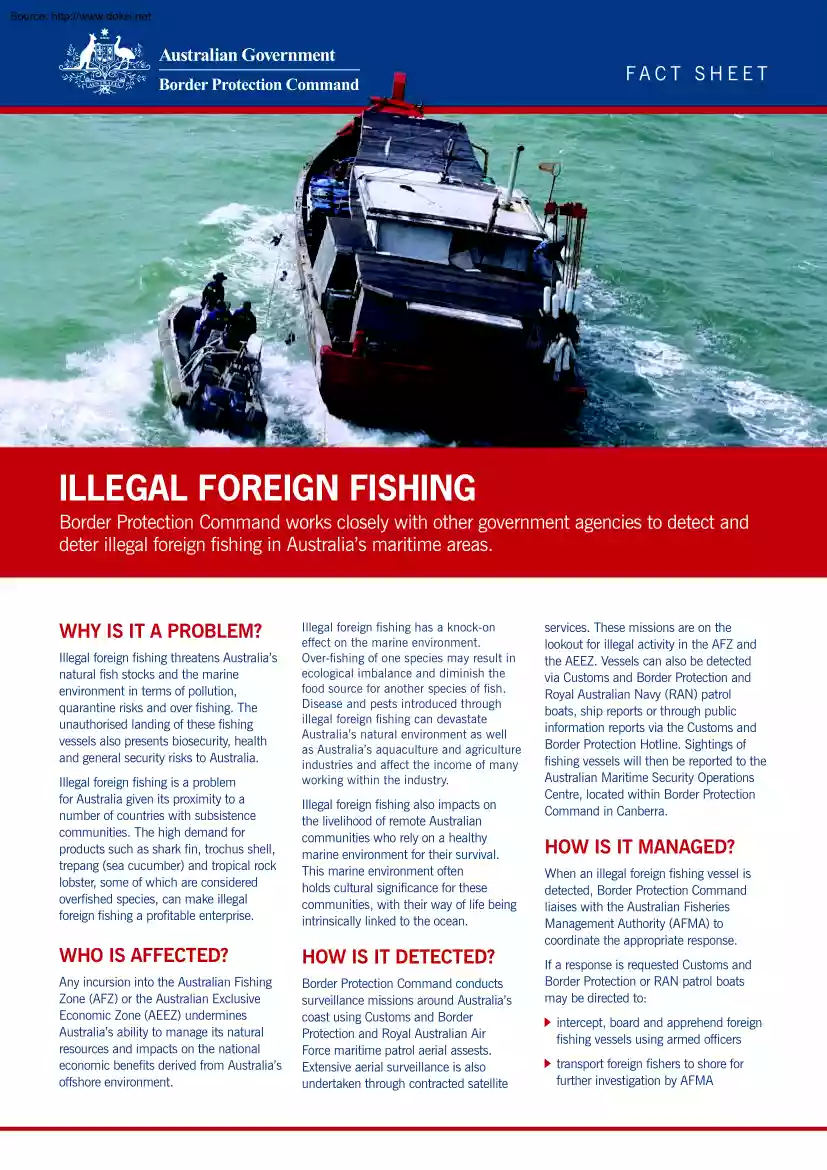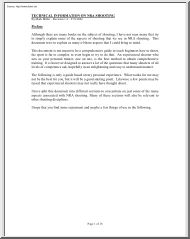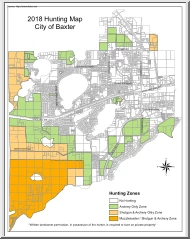Please log in to read this in our online viewer!

Please log in to read this in our online viewer!
No comments yet. You can be the first!
What did others read after this?
Content extract
Source: http://www.doksinet FACT SHEET ILLEGAL FOREIGN FISHING Border Protection Command works closely with other government agencies to detect and deter illegal foreign fishing in Australia’s maritime areas. Why is it a problem? Illegal foreign fishing threatens Australia’s natural fish stocks and the marine environment in terms of pollution, quarantine risks and over fishing. The unauthorised landing of these fishing vessels also presents biosecurity, health and general security risks to Australia. Illegal foreign fishing is a problem for Australia given its proximity to a number of countries with subsistence communities. The high demand for products such as shark fin, trochus shell, trepang (sea cucumber) and tropical rock lobster, some of which are considered overfished species, can make illegal foreign fishing a profitable enterprise. Illegal foreign fishing has a knock-on effect on the marine environment. Over-fishing of one species may result in ecological imbalance and
diminish the food source for another species of fish. Disease and pests introduced through illegal foreign fishing can devastate Australia’s natural environment as well as Australia’s aquaculture and agriculture industries and affect the income of many working within the industry. Illegal foreign fishing also impacts on the livelihood of remote Australian communities who rely on a healthy marine environment for their survival. This marine environment often holds cultural significance for these communities, with their way of life being intrinsically linked to the ocean. Who is affected? How is it detected? Any incursion into the Australian Fishing Zone (AFZ) or the Australian Exclusive Economic Zone (AEEZ) undermines Australia’s ability to manage its natural resources and impacts on the national economic benefits derived from Australia’s offshore environment. Border Protection Command conducts surveillance missions around Australia’s coast using Customs and Border
Protection and Royal Australian Air Force maritime patrol aerial assests. Extensive aerial surveillance is also undertaken through contracted satellite services. These missions are on the lookout for illegal activity in the AFZ and the AEEZ. Vessels can also be detected via Customs and Border Protection and Royal Australian Navy (RAN) patrol boats, ship reports or through public information reports via the Customs and Border Protection Hotline. Sightings of fishing vessels will then be reported to the Australian Maritime Security Operations Centre, located within Border Protection Command in Canberra. How is it managed? When an illegal foreign fishing vessel is detected, Border Protection Command liaises with the Australian Fisheries Management Authority (AFMA) to coordinate the appropriate response. If a response is requested Customs and Border Protection or RAN patrol boats may be directed to: intercept, board and apprehend foreign fishing vessels using armed officers transport
foreign fishers to shore for further investigation by AFMA Source: http://www.doksinet tow/escort foreign boats to port, or destroy these vessels at sea if they are unseaworthy confiscate fishing equipment and catch (known as a legislative forfeiture). These activities aim to deter illegal foreign fishing activity within Australia’s maritime environment and are targeted towards the long-term sustainability of our maritime resources. The management of illegal foreign fishing is based on a risk assessment process ensuring that resources are allocated appropriately. Resources will be concentrated in those areas and on those incidents that represent the highest risk to maritime security. Operational analysis and planning R PROTECT DE BO ION R Border Protection Command conducts analysis of illegal foreign fishing operations. This includes collection of data on illegal foreign fishing vessels activities to better inform operational planning and evaluation. CO M MAND Febuary
2009 Regional Cooperation In Australia’s northern waters, Border Protection Command maintains a robust strategy of maritime surveillance, deterrence and apprehensions. Border Protection Command also supports initiatives to cooperate with other countries within the region to deter illegal foreign fishing at its source. This includes agreements such as the Regional Plan of Action, signed by Australia and nine other Asia-Pacific Economic Cooperation (APEC) countries. This plan will promote responsible fishing practices and facilitate coordinated maritime patrols between Australia and Indonesia. Australia is also funding a public information campaign to inform Indonesian fishing communities about the consequences of illegally fishing in Australian waters. In the Southern Ocean the key strategy is the maintenance of armed patrols of the EEZ of Heard and McDonald Islands underpinned by bilateral Border Protection Command Headquarters, Customs House, 5 Constitution Avenue, Canberra, ACT
2600. Telephone 1300 558 287. Website: www.bpcgovau cooperation and joint surveillance and enforcement activities with France, and cooperation with New Zealand and South Africa. Border Protection Command supports these Customs and Border Protection and Fisheries (AFMA) led operations with information sharing between the relevant Australian agencies
diminish the food source for another species of fish. Disease and pests introduced through illegal foreign fishing can devastate Australia’s natural environment as well as Australia’s aquaculture and agriculture industries and affect the income of many working within the industry. Illegal foreign fishing also impacts on the livelihood of remote Australian communities who rely on a healthy marine environment for their survival. This marine environment often holds cultural significance for these communities, with their way of life being intrinsically linked to the ocean. Who is affected? How is it detected? Any incursion into the Australian Fishing Zone (AFZ) or the Australian Exclusive Economic Zone (AEEZ) undermines Australia’s ability to manage its natural resources and impacts on the national economic benefits derived from Australia’s offshore environment. Border Protection Command conducts surveillance missions around Australia’s coast using Customs and Border
Protection and Royal Australian Air Force maritime patrol aerial assests. Extensive aerial surveillance is also undertaken through contracted satellite services. These missions are on the lookout for illegal activity in the AFZ and the AEEZ. Vessels can also be detected via Customs and Border Protection and Royal Australian Navy (RAN) patrol boats, ship reports or through public information reports via the Customs and Border Protection Hotline. Sightings of fishing vessels will then be reported to the Australian Maritime Security Operations Centre, located within Border Protection Command in Canberra. How is it managed? When an illegal foreign fishing vessel is detected, Border Protection Command liaises with the Australian Fisheries Management Authority (AFMA) to coordinate the appropriate response. If a response is requested Customs and Border Protection or RAN patrol boats may be directed to: intercept, board and apprehend foreign fishing vessels using armed officers transport
foreign fishers to shore for further investigation by AFMA Source: http://www.doksinet tow/escort foreign boats to port, or destroy these vessels at sea if they are unseaworthy confiscate fishing equipment and catch (known as a legislative forfeiture). These activities aim to deter illegal foreign fishing activity within Australia’s maritime environment and are targeted towards the long-term sustainability of our maritime resources. The management of illegal foreign fishing is based on a risk assessment process ensuring that resources are allocated appropriately. Resources will be concentrated in those areas and on those incidents that represent the highest risk to maritime security. Operational analysis and planning R PROTECT DE BO ION R Border Protection Command conducts analysis of illegal foreign fishing operations. This includes collection of data on illegal foreign fishing vessels activities to better inform operational planning and evaluation. CO M MAND Febuary
2009 Regional Cooperation In Australia’s northern waters, Border Protection Command maintains a robust strategy of maritime surveillance, deterrence and apprehensions. Border Protection Command also supports initiatives to cooperate with other countries within the region to deter illegal foreign fishing at its source. This includes agreements such as the Regional Plan of Action, signed by Australia and nine other Asia-Pacific Economic Cooperation (APEC) countries. This plan will promote responsible fishing practices and facilitate coordinated maritime patrols between Australia and Indonesia. Australia is also funding a public information campaign to inform Indonesian fishing communities about the consequences of illegally fishing in Australian waters. In the Southern Ocean the key strategy is the maintenance of armed patrols of the EEZ of Heard and McDonald Islands underpinned by bilateral Border Protection Command Headquarters, Customs House, 5 Constitution Avenue, Canberra, ACT
2600. Telephone 1300 558 287. Website: www.bpcgovau cooperation and joint surveillance and enforcement activities with France, and cooperation with New Zealand and South Africa. Border Protection Command supports these Customs and Border Protection and Fisheries (AFMA) led operations with information sharing between the relevant Australian agencies




 Just like you draw up a plan when you’re going to war, building a house, or even going on vacation, you need to draw up a plan for your business. This tutorial will help you to clearly see where you are and make it possible to understand where you’re going.
Just like you draw up a plan when you’re going to war, building a house, or even going on vacation, you need to draw up a plan for your business. This tutorial will help you to clearly see where you are and make it possible to understand where you’re going.